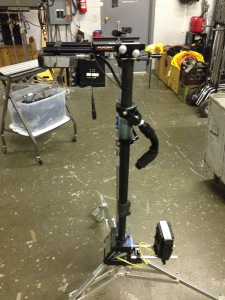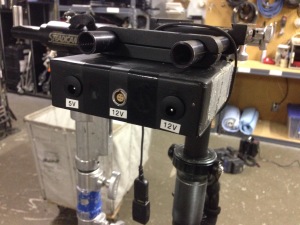Apologies if this is a repeat of previous information, but some of it bears repeating.
The Flycam experiment has essentially ended, as I’ve taken it almost to its breaking point and back. More importantly, I just bought a new arm, so that kinda kills the all-Proaim-testing part of it. I will still have to have an adapter made in order to use that arm, but it’s a Glidecam, which I know works, so it’s not an unknown quantity necessarily.
 So how did the Flycam Flujo do? The maiden voyage (well, maiden series) saw it handling a C300 rig pretty regularly, including an unnecessarily heavy “low-mode cage” that damn near killed it. By the end of my run on the season, I had my transitions to and from Steadi down to five and two minutes, respectively, but that isn’t necessarily the Flujo’s doing. I used it effectively and without any equipment-related mishaps (several operator-related ones notwithstanding.) But there are a lot of things that need fixing.
So how did the Flycam Flujo do? The maiden voyage (well, maiden series) saw it handling a C300 rig pretty regularly, including an unnecessarily heavy “low-mode cage” that damn near killed it. By the end of my run on the season, I had my transitions to and from Steadi down to five and two minutes, respectively, but that isn’t necessarily the Flujo’s doing. I used it effectively and without any equipment-related mishaps (several operator-related ones notwithstanding.) But there are a lot of things that need fixing.
The biggest problem with the entire system is the arm. At some point, probably eight months after buying it (and after about four months of constant usage,) the bearings in the arm started to break. Currently, one of them is completely gone–it must have fallen out on set, and I have no idea when that happened–and the one directly across has shattered. I currently have a steel bolt through the arm where the two bearings are missing, but it’s not the same thickness as the bearings were, and consequently throws off the angle of the first part of the arm pretty severely. Visual inspection reveals that there are several other bearings on the verge of breaking.
The breaking bearings are probably a fault in the manufacturing, but the entire arm being twisted is not. It’s hard to tell, but the entire arm has torqued ever so slightly outwards, probably because it had a great deal of weight on it. The twist causes the sled to move forward, which makes the operator have to lean back, and down that road lie tears and pulled backs. Varying reports list different weight capacities for the rig, and while my setup was on the heavy end, I’m fairly certain that anyone putting anything on this that was smaller would have a bear of a time figuring out what to do with all that extra inertial energy in the arm. The single-point tension adjustments are very nice, but like many things on this rig, are cheap screws and begin to strip and get loose over time.
So the arm is a serious problem in the long run, even with the modifications I made. The different sizes of post actually helped a considerable amount, and I’m going to have to figure out a way to get that same flexibility in my new arm.
The vest is still atrocious, and the sled’s problems were well-documented at the beginning of this series, which is good because I no longer remember what they were. I’ve made quite a few adjustments to the sled, and am currently wiring a new post cable (specifically, HDMI-and-power-tied-together cable.)
But one thing that has absolutely worked is the idea of flexibility. I had the posts and socket-block adapter made so that, when the time came, I could swap an arm, sled, or vest without any other issues. The annoying note here is that I bought a used Glidecam V-25, which actually does have an issue, in that its connection to the vest is incorrect, and I’m having to have another adapter cut at a shop, but that’s only a minor thing. The bones of the system are solid enough to support something like what I’ve done, but it only worked because I have a serious background in this stuff, knew what I wanted, and had operating capital to get it.
All in all, I would not in the least recommend this rig to anyone. It’s been a great deal of trouble, and while it did land me a great job on an amazing set, it’s brought with it a great deal of stress and heartache as things that I shouldn’t have to worry about begin to fail or break.






